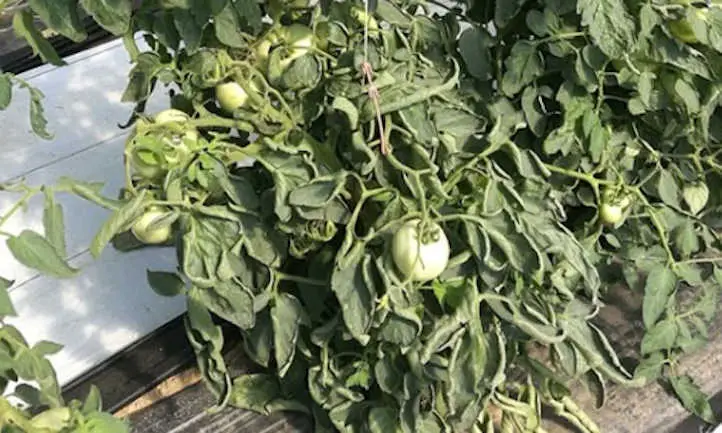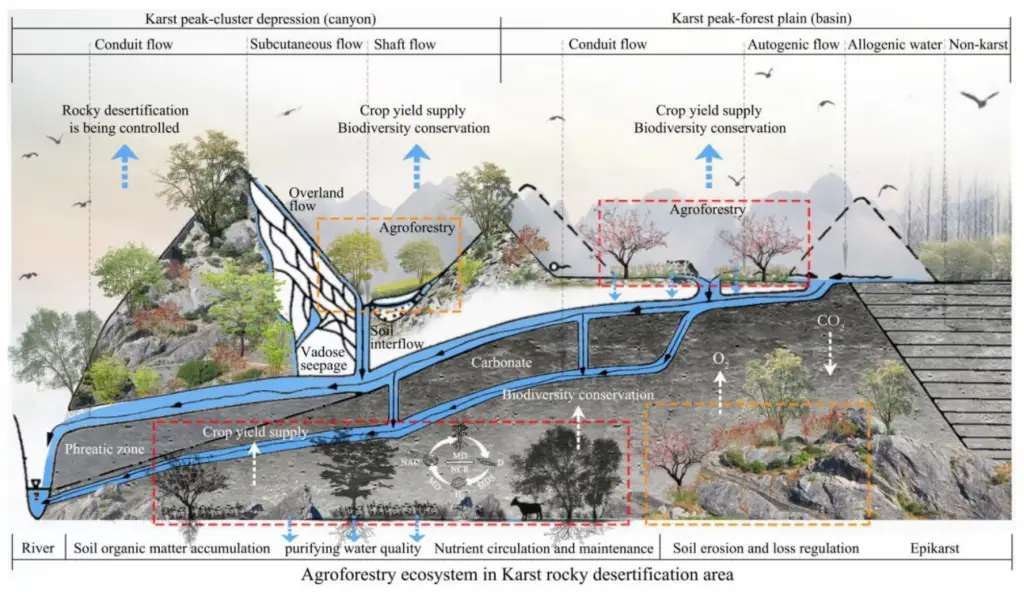Tomato leaves curl up as a protective response to environmental issues such as too much sun, high temperatures, wind, or a lack of water. To fix leaf curl on tomato plants, you can select varieties less prone to curl, maintain adequate soil moisture, avoid excessive fertilizer (especially nitrogen), prune indeterminate varieties conservatively, and provide shade to plants when possible to avoid high temperatures.
It’s important to address these environmental factors to prevent further leaf curl and ensure the health of your tomato plants.
Main Causes Of Leaves Curling Up Tomatoes
- 🌱 Physiological leaf curl is caused by environmental stress such as heat, lack of water, or over-watering. Leaves may roll upward to conserve moisture.
- 🌿 Herbicide drift can cause leaf curl, bending stems, cupped leaves, and discoloration. It affects leaves present during exposure, not new growth.
- 🦠 Viral causes of leaf curl include Curly Top, Yellow Tomato Leaf Mosaic, and Yellow Curly Leaf viruses. They are hard to reverse; infected plants should be removed.
- 🌞 Prevention strategies include using shade cloth to deter leaf hoppers, which spread viruses. Neem oil helps control white flies that transmit Tomato Yellow Leaf Curl virus.
- 🪰 Tomato Yellow Leaf Curl virus causes leaf yellowing, cupping, flower/fruit drop, stunting, and is spread by white flies. Prevent white fly infestations to avoid the virus.

Tomato leaves can curl up due to various causes, usually related to environmental factors. Exposure to excessive sunlight, high temperatures, strong winds, or inadequate watering can lead to tomato leaf curling. Providing proper shade, maintaining optimal temperature and moisture levels, and addressing any nutrient deficiencies can help resolve this issue.
Leaves curling up on tomato plants can be a concerning sight for gardeners. Several factors, including environmental conditions and pest infestations, can contribute to this issue. Let’s take a closer look at some common causes of leaf curling in tomatoes:
Ecological Factors And Leaf Curling
- Excessive sun exposure: When tomato plants are exposed to intense sunlight for prolonged periods, their leaves may curl up to reduce water loss and prevent damage. This is commonly known as sunscald. Providing shade or using shade cloth can help protect the plants.
- High temperatures: Tomato plants are sensitive to heat and may experience leaf curling in response to scorching weather. Ensure proper air circulation and consider using mulch to regulate soil temperature.
- Strong winds: Strong winds can cause leaves to curl up as a protective measure against dehydration. Building windbreaks or providing support for the plants can help minimize the impact of wind.
- Water deficiency: Insufficient watering can lead to leaf curling in tomatoes. Maintaining consistent soil moisture levels is essential for the health of the plants. Be sure to water deeply and regularly, especially during hot and dry periods.
Leaf Hopper Infestation And Leaf Curling
- Leafhopper infestation: Leaf hoppers are tiny, sap-sucking insects that can transmit viruses to tomato plants. When leaves curl up and show signs of discoloration or spotting, it may indicate a leaf hopper infestation. Control measures like insecticides and removing infected plants can help manage the problem.
Curly Top Virus And Tomato Leaf Curling
- Curly top virus: The curly full virus is a severe disease that affects tomatoes and other plants. Leaf hoppers transmit it and cause curling of the leaves, stunted growth, and discoloration. There is no cure for the virus, so prevention is crucial. Remove infected plants to prevent the virus from spreading.
By understanding the causes of leaf curling in tomatoes, you can take appropriate measures to prevent and manage the issue in your garden. Regular monitoring, proper watering, and implementing pest control techniques are vital to maintaining healthy plants.
Solutions For Leaves Curling Up Tomatoes
The leaves curling up on tomatoes often respond to environmental issues such as too much sun, high temperatures, strong winds, or insufficient water. To resolve this problem, provide shade, maintain proper watering, and protect the plants from extreme weather conditions.
Tomato plants are susceptible to leaf curling, which can be caused by various factors such as environmental conditions, pests, and diseases. To address this issue and promote healthy tomato growth, the following solutions can be implemented:
Providing Adequate Shade For Tomato Plants
- Using shade cloth: Install shade cloth above the tomato plants to protect them from excessive sunlight and heat. This will help prevent leaf curling caused by high temperatures.
- Creating natural shaded areas: Plant taller crops or erect structures near the tomato plants to create shade. This will help regulate the temperature and prevent leaf curling.
Learn more about why plant leaves turn yellow:
Proper Watering Techniques
- Determining watering needs: Assess the moisture content of the soil by inserting a finger or a moisture meter into the soil. Water the tomato plants when the top inch of soil feels dry.
- Avoid overwatering: Do not overwater the tomato plants, as this can lead to waterlogged soil and root rot, which can cause leaf curling.
- Addressing water deficiency: Ensure that the tomato plants receive sufficient water to prevent leaf curling due to water deficiency.
Pest Control Measures
- Preventing leaf hopper infestation: Regularly inspect the tomato plants for leaf hoppers. Use organic insecticides or physical barriers to deter leaf hoppers from infesting the plants.
- Managing leaf hopper population: If leaf hoppers are present, introduce natural predators like ladybugs or lacewings to control their population.
- Removing infected leaves: If the tomato plants show signs of leaf curling due to leaf hopper infestation, remove the infected leaves to prevent the spread of the infestation.
Preventing And Managing Curly Top Virus
- Using disease-resistant tomato varieties: Plant disease-resistant tomato varieties are less susceptible to curly top viruses.
- Maintaining hygiene and sanitation: Keep the garden clean by removing weeds and debris, which can harbor curly top viruses. Preventive measures like crop rotation can also help minimize the risk of viral infections.
- Seeking professional help if necessary: If the tomato plants are severely affected by the curly top virus, seek guidance from a professional horticulturist or agricultural extension office for appropriate management strategies.
Nutrient Balance And Fertilizing
- Identifying nutritional deficiencies: Observe the tomato plants for signs of nutrient deficiencies, such as yellowing or curling leaves. Conduct soil tests to determine the specific nutrient deficiencies.
- Providing balanced fertilization: Apply fertilizers formulated explicitly for tomatoes or amend the soil with organic matter to address nutrient deficiencies.
- Using organic and slow-release fertilizers: Use organic fertilizers or slow-release fertilizers to provide a continuous supply of nutrients to the tomato plants.
Creating An Optimal Growing Environment
- Proper plant spacing: Ensure adequate spacing between tomato plants to promote air circulation and prevent overcrowding, which can lead to leaf curling.
- Mulching to retain moisture and regulate temperature: Apply a layer of organic mulch around the tomato plants to maintain soil moisture and control the temperature, preventing leaf curling caused by extreme conditions.
- Maintaining air circulation: Avoid planting tomato plants in locations with limited airflow. Prune excessive foliage to improve air circulation and reduce the risk of leaf curling.
Implementing these solutions will help prevent and address leaf curling in tomato plants, ensuring their healthy growth and productivity. Remember to closely monitor the plants and adjust the answers for optimal results.
Frequently Asked Questions Of Leaves Curling Up Tomatoes
Why Are My Tomato Plant Leaves Curling Upwards?
Tomato plant leaves curling upwards are usually a response to environmental factors. Excessive exposure to sunlight, high temperatures, strong winds, or insufficient water can cause the leaves to curl up as a protective measure. You can implement a few management strategies to fix leaf curls on tomato plants.
First, select varieties that are less prone to leaf curl. Ensure that the soil has adequate moisture by watering regularly. Avoid excessive fertilizer use, especially nitrogen. Prune indeterminate varieties conservatively. If possible, provide shade to the plants during hot weather.
By addressing these environmental factors and providing optimal growing conditions, you can help prevent or mitigate leaf curl in tomato plants.
How Do You Fix Leaf Curl On Tomato Plants?
To fix leaf curls on tomato plants, follow these management strategies:
1. Select tomato varieties less prone to leaf curl.
2. Maintain adequate soil moisture for the plants.
3. Avoid excessive use of nitrogen fertilizer.
4. Prune indeterminate tomato varieties conservatively.
5. Provide shade to the plants during high temperatures, if feasible. Leaf curl on tomato plants is often a response to environmental issues. Excessive sunlight, high temperatures, strong winds, or insufficient water can cause the leaves to curl up as a protective measure.
Addressing these factors and implementing the suggested strategies can help prevent and alleviate leaf curl on tomato plants. Remember to choose suitable tomato varieties, ensure proper watering, avoid over-fertilization, prune appropriately, and provide shade when needed.
Can Overwatering Cause Tomato Leaves To Curl?
Yes, overwatering can cause tomato leaves to curl.
Why Are My Tomato Leaves Curling In Hot Weather?
Tomato leaves curl in hot weather due to environmental factors. When exposed to excessive sunlight, high temperatures, strong winds, or lack of water, tomato plants respond by curling their leaves to protect themselves. This type of leaf curl is a physiological response and occurs almost 100% of the time.
Specific management strategies can be implemented to fix leaf curls on tomato plants. These include selecting varieties that are less prone to leaf curl, maintaining adequate soil moisture, avoiding excessive fertilizer (especially nitrogen), pruning indeterminate varieties conservatively, and providing shade for the plants when possible to mitigate high temperatures.
Addressing these factors can help prevent or manage leaf curl in tomato plants during hot weather.
Conclusion
To summarize, if you notice your tomato plant leaves curling upwards, it is most likely a response to environmental issues. This type of leaf curl is a protective mechanism, indicating that your plant is exposed to excessive sun, high temperatures, strong winds, or insufficient water.
To fix this issue, you can take specific management strategies. First, choose tomato varieties that are less prone to leaf curl. Ensure your soil has adequate moisture, but be careful not to over-fertilize, especially with nitrogen. Pruning indeterminate varieties conservatively can also help.
If possible, provide shade to your plants to prevent high temperatures. Implementing these strategies can effectively address leaf curls and promote healthy tomato growth. Consider your plant’s needs and provide the appropriate care for optimal results.
Related Articles:
Lightning Strikes Threat: Boreal Fires Jeopardize Carbon
 Dr Ahsanur Rahman, PHD
Dr Ahsanur Rahman, PHD
Bird Diversity in Agroforestry: Eco-Balance in the Tropics
 Dr Ahsanur Rahman, PHD
Dr Ahsanur Rahman, PHD







